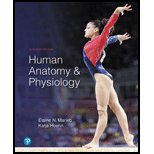
Concept explainers
To determine:
The stimulus for vision from following forms of energy:
(a) Chemical
(b) Electrical
(c) Mechanical
(d) Radiant
Answer to Problem 1RQ
Solution:
(c) Radiant: Vision is found operable only in the presence of light and light is classified as a form of radiant energy. The radiant energy can be defined as the energy of the gravitational radiation and
Explanation of Solution
The radiant energy is usually used in the lighting, heating, solar energy, and radiometry. The radiant energy travels in the form of waves. The lengths of these waves are different and the spectrum of these waves is known as the electromagnetic spectrum. The radiant energy includes infrared waves, ultraviolet waves, X-rays, visible light, and radio waves. The light energy stimulates the eyes and plays a significant role in vision.
Want to see more full solutions like this?
Chapter 2 Solutions
Human Anatomy & Physiology (11th Edition)
- 4). Imagine there are 2 alleles at a locus (A and a). a). If p = 0.75, what is q? b). Given p of 0.75, what is p²? c). For a sample of 200 individuals and if p = 0.75, how many individuals would we expect to carry the genotype AA? d). For a sample of 200 individuals, if p = 0.75, how many individuals would we expect to carry the genotype Aa? e) For a sample of 200 individuals, if p = 0.75, how many individuals would we expect to carry the genotype aa?arrow_forwardOur body-water-compartments can be separated into three distinct andfundamental regions. Which of the three is the largest?a. Plasmab. Interstitial fluidc. Intracellulard. All of the above are the same volume; and must always stay the samearrow_forwardOur body-water-compartments can be separated into three distinct andfundamental regions. Which of the three is the largest?a. Plasmab. Interstitial fluidc. Intracellulard. All of the above are the same volume; and must always stay the samearrow_forward
- Proteins serve as the “machinery” for the living cells. What type of moleculesserve as blueprints and allow a cell to correctly produce its’ proteins?A. CarbohydratesB. GenesC. GametesD. Lipidsarrow_forwardWhich of the following molecules will not dissolve in water?a. Non-polar Lipophilic moleculesb. Glucosec. Polar Hydrophilic moleculesd. Electrolytese. None of the above is correctarrow_forwardPhospholipids:A. are proteins.B. are amphipathic.C. are amino acid polymers.D. are monosaccharidesarrow_forward
- Enzymes are:A. proteinsB. nucleic acid polymersC. lipidsD. phospholipid polymersarrow_forwardWhich of the following molecules possess both polar (hydrophilic) & non-polar(hydrophobic) regions?A. triglyceridesB. carbohydratesC. phospholipids.D. Both A and B are correctarrow_forwardThe functional structure of a protein is its' _________________ structure,which is ultimately determined by the __________________.A. tertiary; primary structure.B. primary; ions it possesses.C. tertiary; concentration of phosphates.D. monogamous; first amino acid on the terminal sequencearrow_forward
- The sub-atomic particles which possess a positive charge are the:A. protonsB. neutronsC. electronsD. croutonsarrow_forwardThe ability or capacity to “store” Energy, from the Sun, is limited to a certaintype of molecule found on the planet. Which of the following characteristicsallow molecules to harness and store “sunlight” energy?A. molecules like electrolytes because they have charge.B. molecules like water because they are everywhere.C. molecules with Carbon – Carbon & Carbon – Hydrogen Bonds.D. molecules found only in the gaseous form.arrow_forwardAn ionic reaction leads to formation of:A. cations and anions.B. amino acids and fatty acids.C. glycogen from glucose.D. carbohydratesarrow_forward
 Human Anatomy & Physiology (11th Edition)BiologyISBN:9780134580999Author:Elaine N. Marieb, Katja N. HoehnPublisher:PEARSON
Human Anatomy & Physiology (11th Edition)BiologyISBN:9780134580999Author:Elaine N. Marieb, Katja N. HoehnPublisher:PEARSON Biology 2eBiologyISBN:9781947172517Author:Matthew Douglas, Jung Choi, Mary Ann ClarkPublisher:OpenStax
Biology 2eBiologyISBN:9781947172517Author:Matthew Douglas, Jung Choi, Mary Ann ClarkPublisher:OpenStax Anatomy & PhysiologyBiologyISBN:9781259398629Author:McKinley, Michael P., O'loughlin, Valerie Dean, Bidle, Theresa StouterPublisher:Mcgraw Hill Education,
Anatomy & PhysiologyBiologyISBN:9781259398629Author:McKinley, Michael P., O'loughlin, Valerie Dean, Bidle, Theresa StouterPublisher:Mcgraw Hill Education, Molecular Biology of the Cell (Sixth Edition)BiologyISBN:9780815344322Author:Bruce Alberts, Alexander D. Johnson, Julian Lewis, David Morgan, Martin Raff, Keith Roberts, Peter WalterPublisher:W. W. Norton & Company
Molecular Biology of the Cell (Sixth Edition)BiologyISBN:9780815344322Author:Bruce Alberts, Alexander D. Johnson, Julian Lewis, David Morgan, Martin Raff, Keith Roberts, Peter WalterPublisher:W. W. Norton & Company Laboratory Manual For Human Anatomy & PhysiologyBiologyISBN:9781260159363Author:Martin, Terry R., Prentice-craver, CynthiaPublisher:McGraw-Hill Publishing Co.
Laboratory Manual For Human Anatomy & PhysiologyBiologyISBN:9781260159363Author:Martin, Terry R., Prentice-craver, CynthiaPublisher:McGraw-Hill Publishing Co. Inquiry Into Life (16th Edition)BiologyISBN:9781260231700Author:Sylvia S. Mader, Michael WindelspechtPublisher:McGraw Hill Education
Inquiry Into Life (16th Edition)BiologyISBN:9781260231700Author:Sylvia S. Mader, Michael WindelspechtPublisher:McGraw Hill Education





